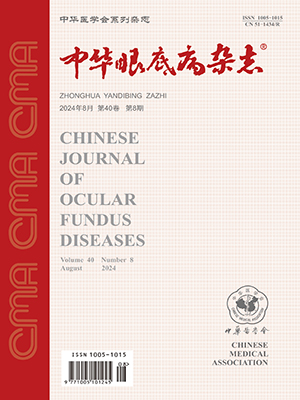| 1. |
Wong TY, Klein R, Islam FM, et al.Diabetic retinopathy in a multi-ethnic cohort in the United States[J].Am J Ophthalmol, 2006, 141(3):446-455.
|
| 2. |
张蕾, 许维强, 谭荣强, 等.糖尿病视网膜病变筛查方式探讨[J].国际眼科杂志, 2010, 10(3):482-484.DOI:10.3969/j.issn.1672-5123.2010.03.026.Zhang L, Xu WQ, Tan RQ, et al.Study of diabetic retinopathy screening modes[J].Int Eye Sci, 2010, 10(3):482-484.DOI:10.3969/j.issn.1672-5123.2010.03.026.
|
| 3. |
康立华, 杨金奎, 王光璐, 等.单视野免散瞳数码眼底照相筛查糖尿病视网膜病变敏感性和特异性[J].医学研究杂志, 2007, 36(7):25-28.DOI:10.3969/j.issn.1673-548X.2007.07.010.Kang LH, Yang JK, Wang GL, et al.The sensitivity and specificity of one-field, non-mydriatic, 45° digital photography for diabetic retinopathy screening[J].J Med Res, 2007, 36(7):25-28.DOI:10.3969/j.issn.1673-548X.2007.07.010.
|
| 4. |
李毅斌, 张丽丽, 石敬, 等.糖尿病视网膜病变的数码眼底照相筛查方法评价[J].眼科, 2008, 17(5):331-334.Li YB, Zhang LL, Shi J, et al.An evaluation on screening of diabetic retinopathy with digital fundus photography[J].Ophthalmol CHN, 2008, 17(5):331-334.
|
| 5. |
Silva PS, Cavallerano JD, Sun JK, et al.Nonmydriatic ultrawide field retinal imaging compared with dilated standard 7-field 35-mm photography and retinal specialist examination for evaluation of diabetic retinopathy[J]. Am J Ophthalmol, 2012, 154(3):549-559.DOI:10.1016/j.ajo.2012.03.019.
|
| 6. |
Kernt M, Hadi I, Pinter F, et al.Assessment of diabetic retinopathy using nonmydriatic ultra-widefield scanning laser ophthalmoscopy (Optomap) compared with ETDRS 7-field stereo photography[J].Diabetes Care, 2012, 35(12):2459-2463.DOI:10.2337/dc12-0346.
|
| 7. |
Robert MJP, Shahrnaz I, Ankur G, et al.Comparison of Optomap ultrawide-field imaging versus slit-lamp biomicroscopy for assessment of diabetic retinopathy in a real-life clinic[J].Clin Ophthalmol, 2014, 29(8):1413-1417.DOI:10.2147/OPTH.S66700.eCollection2014.
|
| 8. |
Neubauer AS, Kernt M, Haritoglou C, et al.Nonmydriatic screening for diabetic retinopathy by ultra-widefield scanning laser ophthalmoscopy(Optomap)[J]. Graefe's Arch Clin Exp Ophthalmol, 2008, 246(2):229-235.
|
| 9. |
Khandhadia S, Madhusudhana KC, Kostakou A, et al. Use of Optomap for retinal screening within an eye casualty setting[J].Br J Ophthalmol, 2009, 93(1):52-55.DOI:10.1136/bjo.2008.148072.
|
| 10. |
Kernt M, Pinter F, Hadi I, et al.Diabetic retinopathy:comparison of the diagnostic features of ultra-widefield scanning laser ophthalmoscopy Optomap with EDTRS 7-field fundus photography[J].Ophthalmologe, 2011, 108(2):117-123.DOI:10.1007/s00347-010-2226-4.
|
| 11. |
赵堪兴, 杨培增, 瞿佳, 等.眼科学[M].8版.北京:人民卫生出版社, 2013:218-219.Zhao KX, Yang PZ, Qu J, et al. Ophthalmology[M].8th ed.Beijing:The People's Medical Publishing House, 2013:218-219.
|
| 12. |
Raffael L, Kristine L, Lala C, et al.Nonmydriatic ultra-wide-field scanning laser ophthalmoscopy(Optomap) versus two-field fundus photography in diabetic retinopathy[J].Ophthalmologica, 2014, 231(1):31-36.DOI:10.1159/000355092.
|
| 13. |
Brown K, Sewell JM, Trempe C, et al.Comparison of image-assisted versus traditional fundus examination[J].Eye Brain, 2013, 5(1):1-8.
|




